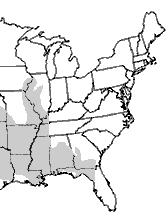Alligator Snapping Turtle (Macrochelys temminckii)



Photos by J.D. Willson unless otherwise noted
| Description: Alligator snapping turtles hold the record as the largest freshwater turtle in North America, with the males reaching carapace lengths of 31 inches (80 cm) and weights of 200 lbs (90kg ). They have very large heads, strongly hooked beaks, and long tails. Their dark brown carapace has three longitudinal keels and is strongly serrated along the rear edge. The only turtle they could be confused with is the common snapper which has a distinctly saw-toothed tail (which the alligator snapper lacks). Their plastrons are much reduced in size compared to their carapaces. Males get much larger than females.
Range and Habitat: The alligator snapping turtle is only found in rivers and streams that flow into the Gulf of Mexico. They are found as far north as Iowa in the Mississippi River drainage, west into eastern Texas, and east into southern Georgia and the Florida panhandle. They do not usually occur in isolated wetlands or ponds, but are found in oxbow lakes. Habits: Alligator snappers have a varied diet including acorns and hickory nuts, berries, other vegetation, and any animal prey found in the water including snakes, salamanders, turtles, fish, and even small alligators, muskrats, and beavers. They use their wormlike tongue as a lure for small prey, snapping their open mouth shut with great force and speed. Juveniles may do this more actively than adults, who may scavenge more. They are extremely aquatic, rarely leaving the water except to nest. They mate in late winter or early spring and lay a single clutch of 10 to 60 eggs which hatch in around 90 days. Conservation Status: Because of their large size and because they can be easily harvested, alligator snapper populations were seriously depleted in the 1970’s and 1980’s to provide meat to soup canneries. Since they mature slowly and have low rates of reproduction, populations take decades to recover from such activities. They are now protected in most parts of their range and are considered Threatened in Georgia. Pertinent References: Pritchard, P. C. H. 1989. The Alligator Snapping Turtle: Biology and Conservation. Milwaukee: Milwaukee Public Museum. Sloan, K. N., K. A. Buhlmann, and J. E. Lovich. 1996. Stomach contents of commercially harvested adult alligator snapping turtles, Macroclemys temminckii. Chelonian Conservation and Biology 2: 96-99. Account Author: Judith Greene, SREL |
